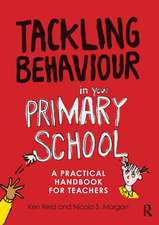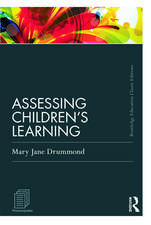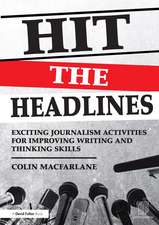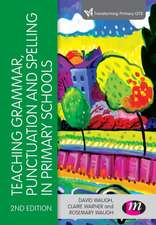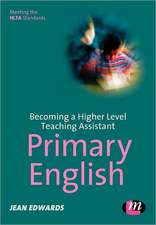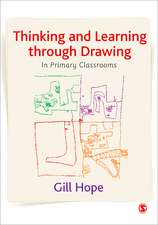Yes, but why? Teaching for understanding in mathematics
Autor Ed Southallen Limba Engleză Paperback – 5 mai 2021
This second edition includes:
· A new ‘Test yourself’ feature in every chapter
· More coverage of the four operations
· Enhanced discussion of fractions and proportionality
· Downloadable figures for use in the classroom
| Toate formatele și edițiile | Preț | Express |
|---|---|---|
| Paperback (2) | 246.39 lei 3-5 săpt. | +30.25 lei 7-13 zile |
| SAGE Publications – 5 mai 2021 | 246.39 lei 3-5 săpt. | +30.25 lei 7-13 zile |
| SAGE Publications – 26 feb 2017 | 471.04 lei 38-44 zile | |
| Hardback (1) | 461.85 lei 3-5 săpt. | +44.91 lei 7-13 zile |
| SAGE Publications – 5 mai 2021 | 461.85 lei 3-5 săpt. | +44.91 lei 7-13 zile |
Preț: 246.39 lei
Nou
Puncte Express: 370
Preț estimativ în valută:
47.15€ • 51.37$ • 39.73£
47.15€ • 51.37$ • 39.73£
Carte disponibilă
Livrare economică 02-16 aprilie
Livrare express 19-25 martie pentru 40.24 lei
Preluare comenzi: 021 569.72.76
Specificații
ISBN-13: 9781526492500
ISBN-10: 1526492504
Pagini: 400
Dimensiuni: 186 x 232 x 23 mm
Greutate: 0.69 kg
Ediția:Second Edition
Editura: SAGE Publications
Colecția Corwin UK
Locul publicării:London, United Kingdom
ISBN-10: 1526492504
Pagini: 400
Dimensiuni: 186 x 232 x 23 mm
Greutate: 0.69 kg
Ediția:Second Edition
Editura: SAGE Publications
Colecția Corwin UK
Locul publicării:London, United Kingdom
Cuprins
Chapter 1: Types of Numbers (Part 1)
Chapter 2: The Four Operations: Addition and Subtraction
Chapter 3: Multiplication and Division
Chapter 4: Angles and Shapes
Chapter 5: Types of Numbers (Part 2)
Chapter 6: Fractions
Chapter 7: Proportionality
Chapter 8: Measurement
Chapter 9: Algebra
Chapter 10: Statistics and Probability
Chapter 11: Functions and Linear Graphs
Chapter 12: The Pythagorean Theorem and Trigonometry
Chapter 2: The Four Operations: Addition and Subtraction
Chapter 3: Multiplication and Division
Chapter 4: Angles and Shapes
Chapter 5: Types of Numbers (Part 2)
Chapter 6: Fractions
Chapter 7: Proportionality
Chapter 8: Measurement
Chapter 9: Algebra
Chapter 10: Statistics and Probability
Chapter 11: Functions and Linear Graphs
Chapter 12: The Pythagorean Theorem and Trigonometry
Notă biografică
Descriere
The bestselling essential guide for mathematics teachers and those training to teach, Yes, but why? answers all your questions, and sheds light on the hidden connections between everything in mathematics at school. The new edition includes a new 'Test Yourself' feature, additional coverage on fractions and much more!
Recenzii
Ed Southall’s new book “Yes, but why? Teaching for Understanding in Mathematics” is the most interesting mathematics education book that I have read in a long time. It is packed full of fascinating nuggets of information, pedagogical advice and suggestions for the classroom. The authors meticulous research is clear throughout, as is his consideration to correct pedagogy. In my opinion, this book should be required reading for all trainee maths teachers, and even the most experienced teachers will, no doubt, learn something.
This is the book that we've all been waiting for! I thoroughly enjoyed reading it and was astonished by how much new stuff I learnt. This book makes mathematical concepts crystal clear. It provides fascinating insights and helpful teaching tips for a comprehensive range of topics. This book has given me a fresh burst of enthusiasm for teaching our wonderful subject! It's a must buy for all new and experienced maths teachers.
I am currently in my 12th year of teaching maths, and it scares me just how little I really understand about the subject I love.
Why are eleven and twelve not called one-teen and two-teen? Why does a negative times a negative equal a positive? Why can I just flip the second fraction over and change to a multiply when I want to divide? Why does the Venn diagram method produce the highest common factor and lowest common multiple of two numbers? Why is the volume of a pointed shape equal to a third of the volume of the full shape?
I kind of know the answer to these, and I can carry out the skills relatively comfortably myself (unless it is a really nasty fraction, of course), but that is no real help when I am trying to introduce the topic to students and they are asking me why. Now, thanks to Ed’s book, I have the answers and a whole lot more besides.
For this is not just a book packed full of fascinating facts. Scattered through the pages are practical teaching tips that can be used straight away in the classroom.Having read the book, I don’t just have more answers to students’ questions, I also have new ways of introducing and extending topics, and a much more in depth knowledge of a subject I thought I knew pretty well.
Personally, I would make this book compulsory for all trainee teachers, all NQTs, all maths teachers, all Heads of Department, and all Senior Leaders. Basically, everyone. I just wish I had negotiated some kind of commission deal!
If you teach Maths, this is THE book that you need to read - whatever stage of your career or phase you teach. It goes without saying (but I’ll say it anyway) that 'knowing' the material we are teaching is vitally important but Ed manages to combine essential content knowledge with pedagogical knowledge and he does it with such clarity and passion that this book is exactly the type of “subject knowledge” the profession needs.
Page after page is full of “golden nuggets” and practical advice; “Yes, But Why? Teaching for Understanding in Mathematics” should be required reading for every Maths teacher!
For the curious learner inside and in front of every maths teacher asking “Yes but why?”, Ed has compiled an accessible and comprehensive compendium of “well, becauses”. He offers straightforward explanations and diagrams in a thorough breakdown of maths topics from grade 1 to 9. The text is peppered with much-needed derivations of technical vocab, algebraic proofs, and historical origins of maths, not to mention mathematical oddities like the meaning of ‘degenerate polygons’, the ‘obelus’ and ‘sexy prime triplets’! This book has made me a more informed maths teacher and it’s now my go-to repository of mathematical explanations to guide my lesson planning and delivery.
This is the book that we've all been waiting for! I thoroughly enjoyed reading it and was astonished by how much new stuff I learnt. This book makes mathematical concepts crystal clear. It provides fascinating insights and helpful teaching tips for a comprehensive range of topics. This book has given me a fresh burst of enthusiasm for teaching our wonderful subject! It's a must buy for all new and experienced maths teachers.
I am currently in my 12th year of teaching maths, and it scares me just how little I really understand about the subject I love.
Why are eleven and twelve not called one-teen and two-teen? Why does a negative times a negative equal a positive? Why can I just flip the second fraction over and change to a multiply when I want to divide? Why does the Venn diagram method produce the highest common factor and lowest common multiple of two numbers? Why is the volume of a pointed shape equal to a third of the volume of the full shape?
I kind of know the answer to these, and I can carry out the skills relatively comfortably myself (unless it is a really nasty fraction, of course), but that is no real help when I am trying to introduce the topic to students and they are asking me why. Now, thanks to Ed’s book, I have the answers and a whole lot more besides.
For this is not just a book packed full of fascinating facts. Scattered through the pages are practical teaching tips that can be used straight away in the classroom.Having read the book, I don’t just have more answers to students’ questions, I also have new ways of introducing and extending topics, and a much more in depth knowledge of a subject I thought I knew pretty well.
Personally, I would make this book compulsory for all trainee teachers, all NQTs, all maths teachers, all Heads of Department, and all Senior Leaders. Basically, everyone. I just wish I had negotiated some kind of commission deal!
If you teach Maths, this is THE book that you need to read - whatever stage of your career or phase you teach. It goes without saying (but I’ll say it anyway) that 'knowing' the material we are teaching is vitally important but Ed manages to combine essential content knowledge with pedagogical knowledge and he does it with such clarity and passion that this book is exactly the type of “subject knowledge” the profession needs.
Page after page is full of “golden nuggets” and practical advice; “Yes, But Why? Teaching for Understanding in Mathematics” should be required reading for every Maths teacher!
For the curious learner inside and in front of every maths teacher asking “Yes but why?”, Ed has compiled an accessible and comprehensive compendium of “well, becauses”. He offers straightforward explanations and diagrams in a thorough breakdown of maths topics from grade 1 to 9. The text is peppered with much-needed derivations of technical vocab, algebraic proofs, and historical origins of maths, not to mention mathematical oddities like the meaning of ‘degenerate polygons’, the ‘obelus’ and ‘sexy prime triplets’! This book has made me a more informed maths teacher and it’s now my go-to repository of mathematical explanations to guide my lesson planning and delivery.





